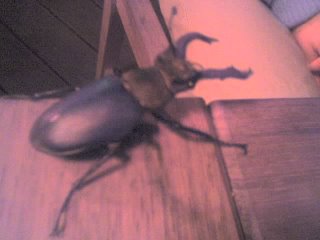How Martin and Jenny came to meet Duncan
It being another delightfully warm summer's evening, Jenny and I decided to relax in the beer garden of the Red Lion in Barnes. This is a really pleasant way to spend a lazy evening actually - with plenty of tables, decking, a few nice ales and even some heat lamps and a marquee-type covering for the more British nights, the Red Lion has a lot going for it.
This traditional English pub is the haunt of your typical Barnsians and a few impostors such as myself and Jenny. As it turns out, the odd endangered species also pops in for quick pint after work now and again.
It was just as well that we had a spare chair around our table tonight as we were graced by the company of an unexpected visitor.
I should add at this point that Jenny has lived most of her life in Guildford, where many of Duncan's friends tend to hang out. Jenny was the first to notice Duncan's presence at the table and immediately identified him as none other than a prime example of a male Lucanus cervus.
This Lucanus cervus is a Stag Beetle to you and me - or Duncan to his friends and relatives.
According to Wikipedia, Stag Beetles "have been in decline over the last 50 years and are now becoming rare and are listed as a Globally threatened / declining species. They have become a protected species under Schedule 5 of the UK's Wildlife and Countryside Act 1981 and the EU Habitats Directive of the Berne Convention. Two of the most important London areas for stag beetles are Richmond Park and Wimbledon Common."
Even better, the article goes on to say "The natural reaction of the beetle to an approaching large object is to remain motionless making them a good photographic subject."
I can personally verify that this is true. Fortunately Jenny had her new Red Motorola SLVR with her, and Duncan posed for these publicity shots very patiently.


I was amazed by it - Duncan was huge - about 7-8cm I reckon. However, he wasn't exactly the smartest of creatures, and had real difficulty when he reached the end of the back of the chair he was walking on: after pausing the think for a while he pretty much just walked straight off it. In his defense, his legs weren't really designed for the smooth wood of the Red Lion's furniture. He hit the decking with a fair thud, but happily crawled up the leg of the table afterwards, and then across the top, perhaps after sip of my Fullers Discovery


I became quite attached to him over the 20 minutes or so he spent with us, and I was worried he'd get trodden on when we left. I carefully coaxed him into an empty glass and took him over to the piles of leaf mould under the bushes nearby where I hope he's still rummaging around now.

Something I learnt from this experience is that Stag Beetles can actually move their horns about, although Duncan only moved his fairly slowly - I don't know how quickly the can potentially. In the first pictures we took you can see Duncan's horns fairly close together, and in later ones at full stretch. It turns out they are in fact enlarged mandibles rather than horns per se. Below is probably the pick of the pics.

I'll be sure to report this sighting on the Stag Beetle Helpline
